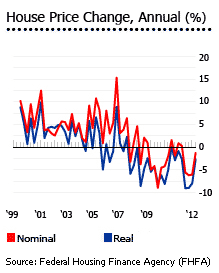 Average rates on fixed mortgages fell this week near record lows.
Average rates on fixed mortgages fell this week near record lows.
Mortgage buyer Freddie Mac said Thursday that the average rate on the 30-year loan dipped to 3.32%. That’s below last week’s 3.34%. And it’s just above 3.31%, lowest rate on records dating to 1971.
The average on the 15-year fixed mortgage declined to 2.66% from 2.67% last week. The record low is 2.63%.
The rate on the 30-year loan has remained below 4% all year, helping spark a modest housing recovery.
Sales of newly built and previously occupied homes are up from a year ago. Home prices have increased. And builders are more confident in the market and are responding by starting construction on more homes.
Rising prices encourage people to sell their homes. And they lead to more buying, in part because some start to worry that prices could rise further.
Lower mortgage rates also have persuaded more people to refinance. That typically leads to lower monthly mortgage payments and more spending with the dollars that are freed up. Consumer spending drives nearly 70% of economic activity.
Still, the housing market has a long way to a full recovery. And many people are unable to take advantage of the low rates, either because they can’t qualify for stricter lending rules or they lack the money to meet larger down payment requirements.
To calculate average mortgage rates, Freddie Mac surveys lenders across the country Monday through Wednesday each week. The average doesn’t include extra fees, known as points, which most borrowers must pay to get the lowest rates. One point equals 1% of the loan amount.
The average fee for 30-year loans was 0.7 point, unchanged from last week. The fee for 15-year loans also was steady, at 0.6 point.
The average rate on a one-year adjustable-rate mortgage declined to 2.53% from 2.55%. The fee for one-year adjustable-rate loans ticked up to 0.5 point from 0.4 point.
The average rate on a five-year adjustable-rate mortgage rose to 2.70% from 2.69% last week. The fee was flat at 0.6 point.
 Puerto Rico’s house prices fell by 1.3% (2.66% in real terms) y-o-y in the second quarter of 2012, according to the Federal Housing Finance Agency (FHFA), a decline noticeably lower than during each of the previous three quarters, which saw average price falls of 5.9% y-o-y (8.7% in real terms).
Puerto Rico’s house prices fell by 1.3% (2.66% in real terms) y-o-y in the second quarter of 2012, according to the Federal Housing Finance Agency (FHFA), a decline noticeably lower than during each of the previous three quarters, which saw average price falls of 5.9% y-o-y (8.7% in real terms).